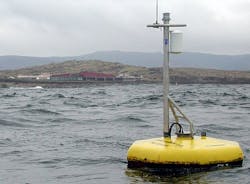Navy choosing rugged fiber optic cable from TE SubCom to connect subsea instruments
PORT HUENEME, Calif., 6 Oct. 2014. U.S. Navy subsea instrument specialists needed optical fiber-based submarine cable to connect deep ocean measurement instruments to shore monitoring stations. They found their solution from Tyco Electronics Subsea Communications LLC (TE SubCom) in Eatontown, N.J.
Officials of the Naval Facilities Engineering and Expeditionary Warfare Center at Port Hueneme, Calif., have awarded a $12.3 million contract to TE SubCom to provide 1,550 kilometers of SL-17 submarine fiber-optic cable.
Navy electro-optical systems designers use the fiber optic cable to connect deep ocean measurement instruments to shore monitoring stations. The contract was announced on 30 Sept. 2014.
Related: DARPA to keep military communications open with floating optical fiber and networking buoys
The Navy primarily has used commercial fiber optic cable from TE SubCom for deep-ocean measurement systems. Company engineers will design the cable to interface with existing Navy seafloor instruments.
Navy researchers and anti-submarine warfare (ASW) experts operate a variety of seafloor instruments. Among these is the centerpiece of U.S. and allied global sonar surveillance called the Integrated Undersea Surveillance System (IUSS).
The IUSS worldwide surveillance network consists of fixed arrays of electronic and optical acoustic sensors on the ocean floor, oceanographic survey ships with long towed-array sonar sensors, and land-based sonar signal-processing sites.
Related: Fiber-optic avionics connectors show performance advantages for avionics systems
The IUSS is the nation's first line of defense against potentially hostile submarines as it monitors sounds in all the world's oceans, while placing special emphasis on monitoring for submarine traffic in strategically important areas and geographical choke points.
The IUSS consists of ocean-floor systems such as the Sound Surveillance System (SOSUS), the Fixed Distributed System-COTS (FDS-C), and Advanced Deployable System (ADS).
SOSUS arrays are installed in strategically important basins in the Atlantic, Pacific, and other ocean areas, alerted Navy officials when Soviet submarines attempted to enter the Caribbean, Gulf of Mexico, or Hudson Bay.
The FDS-C arrays are acoustic sensors on the ocean bottom, connected by optical fiber, and arranged in the shape of a large multi-prong fork or rake, which enables technicians to detect and locate submarines, and also determine their range and bearing.
Related: Optical technology: at the speed of light
The ADS is an outgrowth of the FDS program, except that it is designed to be portable and deployable quickly in ocean areas where it is most needed, such as the Persian Gulf, Red Sea, and Arabian Sea. The ADS is to beef-up undersea surveillance in shallow-water coastal areas where hostile submarines pose the most severe near-term threats.
On the fiber optic cable contract awarded on 30 Sept., TE SubCom will do the work in Eatontown, N.J., and should be finished by July 2015. for more information contact TE SubCom online at www.subcom.com, or the Naval Facilities Engineering and Expeditionary Warfare Center-Port Hueneme at www.navfac.navy.mil.

